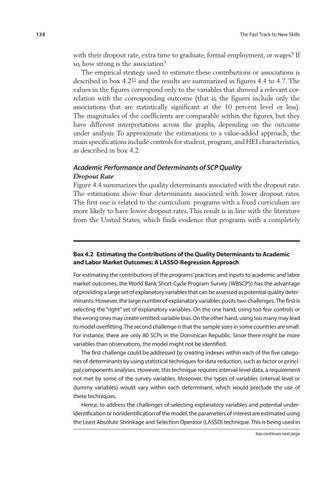138
The Fast Track to New Skills
with their dropout rate, extra time to graduate, formal employment, or wages? If so, how strong is the association? The empirical strategy used to estimate these contributions or associations is described in box 4.221 and the results are summarized in figures 4.4 to 4.7. The values in the figures correspond only to the variables that showed a relevant correlation with the corresponding outcome (that is, the figures include only the associations that are statistically significant at the 10 percent level or less). The magnitudes of the coefficients are comparable within the figures, but they have different interpretations across the graphs, depending on the outcome under analysis. To approximate the estimations to a value-added approach, the main specifications include controls for student, program, and HEI characteristics, as described in box 4.2.
Academic Performance and Determinants of SCP Quality Dropout Rate Figure 4.4 summarizes the quality determinants associated with the dropout rate. The estimations show four determinants associated with lower dropout rates. The first one is related to the curriculum: programs with a fixed curriculum are more likely to have lower dropout rates. This result is in line with the literature from the United States, which finds evidence that programs with a completely
Box 4.2 Estimating the Contributions of the Quality Determinants to Academic and Labor Market Outcomes: A LASSO-Regression Approach For estimating the contributions of the programs’ practices and inputs to academic and labor market outcomes, the World Bank Short-Cycle Program Survey (WBSCPS) has the advantage of providing a large set of explanatory variables that can be assessed as potential quality determinants. However, the large number of explanatory variables posits two challenges. The first is selecting the “right” set of explanatory variables. On the one hand, using too few controls or the wrong ones may create omitted variable bias. On the other hand, using too many may lead to model overfitting. The second challenge is that the sample sizes in some countries are small. For instance, there are only 80 SCPs in the Dominican Republic. Since there might be more variables than observations, the model might not be identified. The first challenge could be addressed by creating indexes within each of the five categories of determinants by using statistical techniques for data reduction, such as factor or principal components analyses. However, this technique requires interval-level data, a requirement not met by some of the survey variables. Moreover, the types of variables (interval level or dummy variables) would vary within each determinant, which would preclude the use of these techniques. Hence, to address the challenges of selecting explanatory variables and potential under identification or nonidentification of the model, the parameters of interest are estimated using the Least Absolute Shrinkage and Selection Operator (LASSO) technique. This is being used in box continues next page

